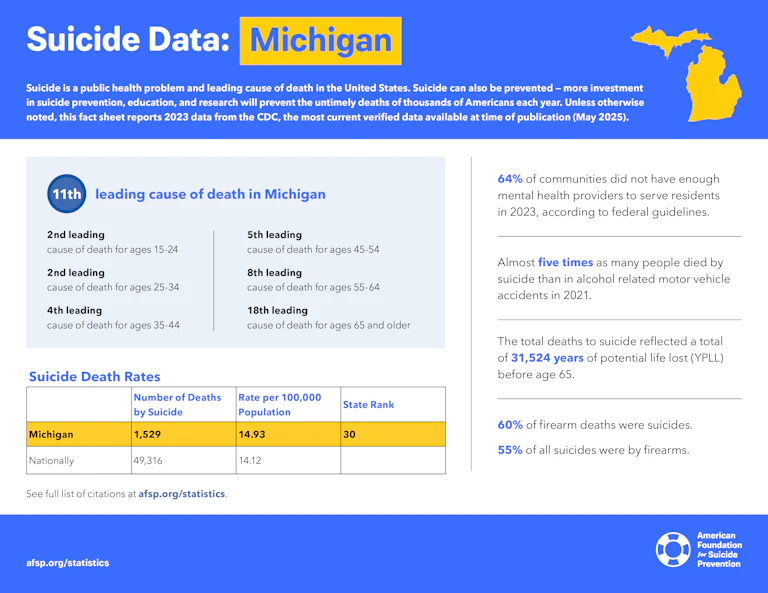Michigan

Michigan suicide prevention plans and initiatives
Michigan’s suicide prevention program is housed in the Michigan Department of Health and Human Services (MDHHS) Injury and Violence Prevention Section, where you can find resources including a map of local coalitions and crisis lines, communication tools, fact sheets, training programs, and an events calendar. In September 2020, MI MDHHS was one of 11 state recipients to be awarded funding in the amount of $8.5 million per year for five years through the CDC’s Comprehensive Suicide Prevention Program. Through these cooperative agreements, the CDC aims to contribute to the national goal of reducing suicide by 20% by 2025 with a focus on vulnerable populations.
In 2019 Michigan law established the Michigan Suicide Prevention Commission within MDHHS to (1) work with state departments and agencies and nonprofit organizations on research factors related to suicide, with a focus on demographics with the highest suicide rates and growth in rates, (2) prepare an annual report for the legislature that includes possible causes for the increase in rates and recommendations for reducing risk factors, (3) annually review, update, and monitor the implementation of recommendations, and (4) ensure a coordinated state approach to suicide prevention. The latest Michigan Suicide Prevention Commission Annual Report was published March 2023.
Michigan laws
Key:
- Required by law
- Encouraged by law
- No law in place
Crisis lines and 988 implementation
- Addresses 988 infrastructure and provides for telecom user fee
- Addresses 988 infrastructure but does not include telecom user fee
- 988 law limited to creating an exploratory commission, advisory committee, or task force
Mental health parity
- Public health plans (e.g., Medicaid) regularly submit parity compliance analyses to state regulators
- Private health plans (individual and group) regularly submit parity compliance analyses to state regulators
K – 12 school suicide prevention
- Inclusion of the 988 Suicide & Crisis Lifeline and/or other crisis line(s) on student ID cards
- Student allowances for excused mental health absences
- School personnel must report student suicide risk to a parent and/or guardian
- Suicide prevention and/or mental health training for certain school personnel, annual
- Suicide prevention and/or mental health training for certain school personnel, not annual
- Suicide prevention, intervention, and postvention policies/programming
- Student education on suicide prevention
Health professional training in suicide assessment, treatment and management
- Mental health professionals receive regular training
- Mental health professionals receive one time training
- Medical/surgical professionals receive regular training
- Medical/surgical professionals receive one time training
Conversion therapy bans
- Prohibits licensed/board certified mental health providers from engaging in conversion therapy with minors under 18 years of age
- Prohibits licensed/board certified mental health providers from engaging in conversion therapy with vulnerable adults
- Prohibits use of state funds for any purpose related to conversion therapy (e.g., conducting, making a referral for, or extending health benefits coverage for)
1
University and college campus suicide prevention
- Inclusion of the 988 Suicide & Crisis Lifeline and/or other crisis line(s) on student ID cards
- Students receive information on available mental health and/or suicide prevention services and/or resources
- Adoption of suicide prevention/awareness policy or program
Firearms
- Process for extreme risk protection orders (ERPOs)
- State voluntary do not sell list